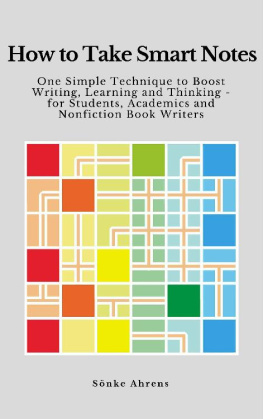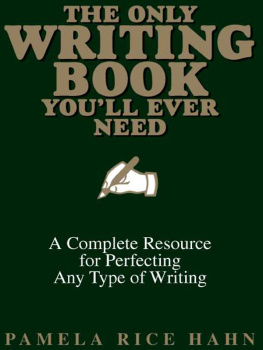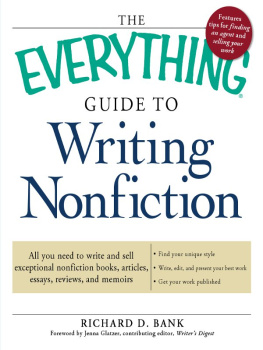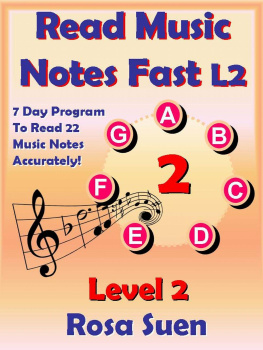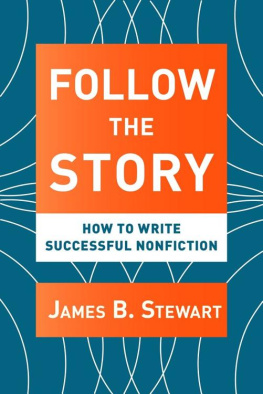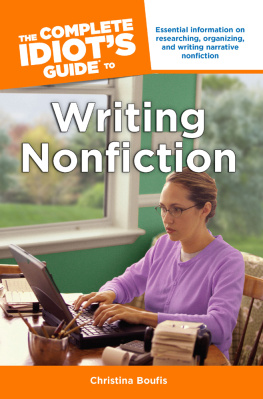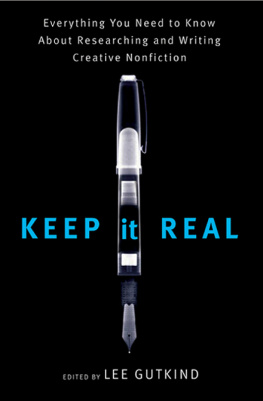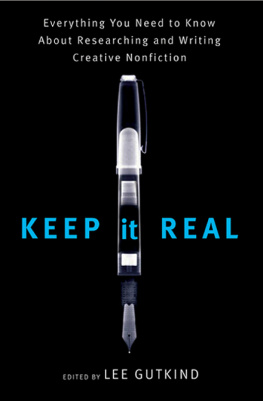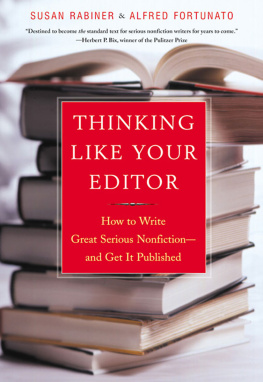Introduction
Everybody writes. Especially in academia. Students write and professorswrite. And nonfiction writers, who are the third group of people this book is aimingto help, obviously write as well. And writing doesnt necessarily mean papers,articles or books, but everyday, basic writing. We write when we need toremember something, be it an idea, a quote or the outcome of a study. We writewhen we want to organise our thoughts and when we want to exchange ideas withothers. Students write when they take an exam, but the first thing they do toprepare even for an oral examination is to grab pen and paper. We write downnot only those things we fear we wont remember otherwise, but also the verythings we try to memorise. Every intellectual endeavour starts with a note.
Writingplays such a central role in learning, studying and research that it issurprising how little we think about it. If writing is discussed ,the focus lies almost always on the few exceptional moments where we write alengthy piece, a book, an article or, as students, the essays and theses wehave to hand in. At first glance, that makes sense: these are the tasks thatcause the most anxiety and with which we struggle the longest. Consequently,these written pieces are also what most self-help books for academics orstudy guides focus on, but very few give guidance for the everyday note-takingthat takes up the biggest chunk of our writing.
Theavailable books fall roughly into two categories. The first teaches the formalrequirements: style, structure or how to quote correctly. And then there arethe psychological ones, which teach you how to get it done without mentalbreakdowns and before your supervisor or publisher starts refusing to move thedeadline once more. What they all have in common, though, is that they startwith a blank screen or sheet of paper.But by doing this, they ignore the main part, namely note-taking, failing tounderstand that improving the organisation of all writing makes adifference. They seem to forget that the process of writing starts much, muchearlier than that blank screen and that the actual writing down of the argumentis the smallest part of its development. This book aims to fill this gap byshowing you how to efficiently turn your thoughts and discoveries intoconvincing written pieces and build up a treasure of smart and interconnectednotes along the way. You can use this pool of notes not only to make writingeasier and more fun for yourself, but also to learn for the long run andgenerate new ideas. But most of all, you can write every day in a way thatbrings your projects forward.
Writingis not what follows research, learning or studying, it is the medium ofall this work. And maybe that is the reason why we rarely think about thiswriting, the everyday writing, the note-taking and draft-making. Likebreathing, it is vital to what we do, but because we do it constantly, itescapes our attention. But while even the best breathing technique wouldprobably not make much of a difference to our writing, any improvement in theway we organise the everyday writing, how we take notes of what we encounterand what we do with them, will make all the difference for the moment we doface the blank page/screen or rather not, as those who take smartnotes will never have the problem of a blank screen again.
Thereis another reason that note-taking flies mostly under the radar: We dontexperience any immediate negative feedback if we do it badly. But without animmediate experience of failure, there is also not much demand for help. Andthe publishing market working how it works, there is not much help in supplyfor this lack of demand either. It is the panic in front of the blank screenthat brings students and academic writers to turn to the bookshelves full ofself-help books on writing, a market publishers meet in droves by focusing onhow to deal with this horse-has-already-left-the-barn situation. If we takenotes unsystematically, inefficiently or simply wrong, we might not evenrealise it until we are in the midst of a deadline panic and wonder why therealways seem to be a few who get a lot of good writing done and still have timefor a coffee every time we ask them. And even then, it is more likely that someform of rationalization will cloud the view of the actual reason, which is mostlikely the difference between good and bad note-taking. Some people are justlike that, writing has to be difficult, the struggle is part of the dealare just a few of the mantras that keep too many from inquiring what exactlydistinguishes successful writing strategies from less successful ones.
Theright question is: What can we do differently in the weeks, months or evenyears before we face the blank page that will get us into the bestpossible position to write a great paper easily? Very few people struggle withtheir papers because they dont know how to cite correctly or because theysuffer from a psychological issue that keeps them from writing. Few struggle totext their friends or write emails. The rules of citation can be looked up andthere is no way that there are as many mental issues as papers postponed. Mostpeople struggle for much more mundane reasons, and one is the myth of the blankpage itself. They struggle because they believe, as they are made tobelieve, that writing starts with a blank page. If you believe that you haveindeed nothing at hand to fill it, you have a very good reason to panic. Justhaving it all in your head is not enough, as getting it down on paper is thehard bit. That is why good, productive writing is based on good note-taking.Getting something that is already written into another written piece isincomparably easier than assembling everything in your mind and then trying toretrieve it from there.
Tosum it up: The quality of a paper and the ease with which it is written dependsmore than anything on what you have done in writing before you even made adecision on the topic. But if that is true (and I wholeheartedly believe itis), and the key to successful writing lies in the preparation, it also meansthat the vast majority of self-help books and study guides can only help you toclose the barn door correctly and according to official rules not just amoment, but many months after the horse has already escaped.
Withthat in mind, it is not surprising that the single most important indicator ofacademic success is not to be found in peoples heads, but in the way they dotheir everyday work. In fact, there is no measurable correlation between a highIQ and academic success at least not north of 120. Yes, a certainintellectual capacity helps to get into academia, and if you struggle severelywith an IQ test, it is likely that you will struggle to solve academicproblems, too. But once you are in, a superior IQ will neither help you todistinguish yourself nor protect you from failure. What does make asignificant difference along the whole intelligence spectrum is something else:how much self-discipline or self-control one uses to approach the tasks at hand(Duckworth and Seligman, 2005; Tangney, Baumeister, and Boone, 2004).

